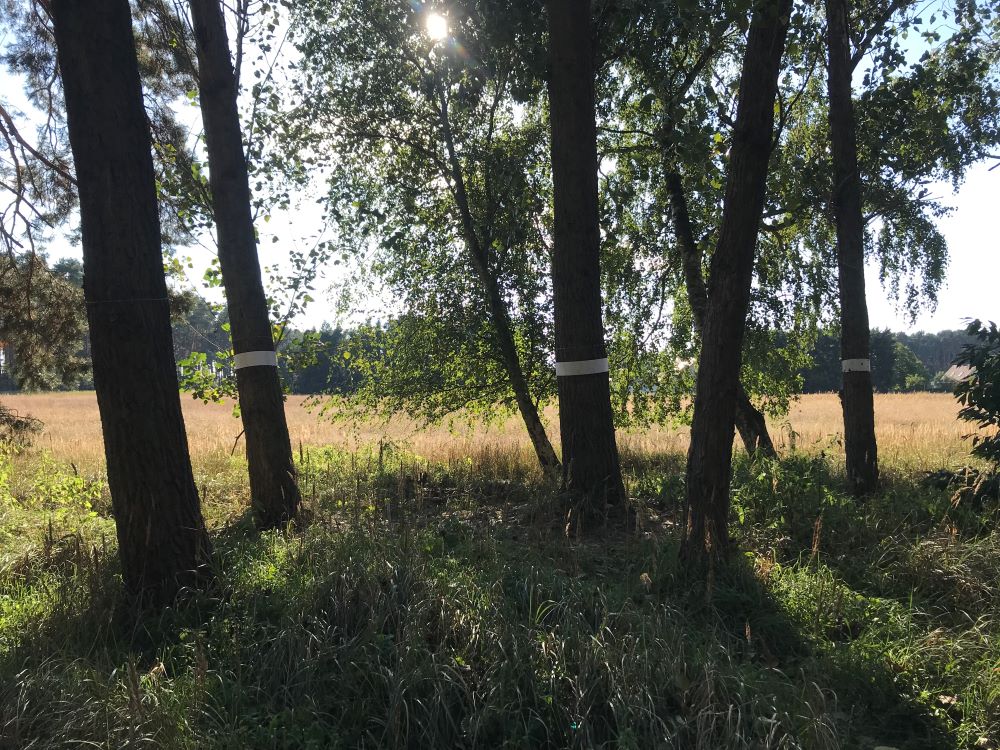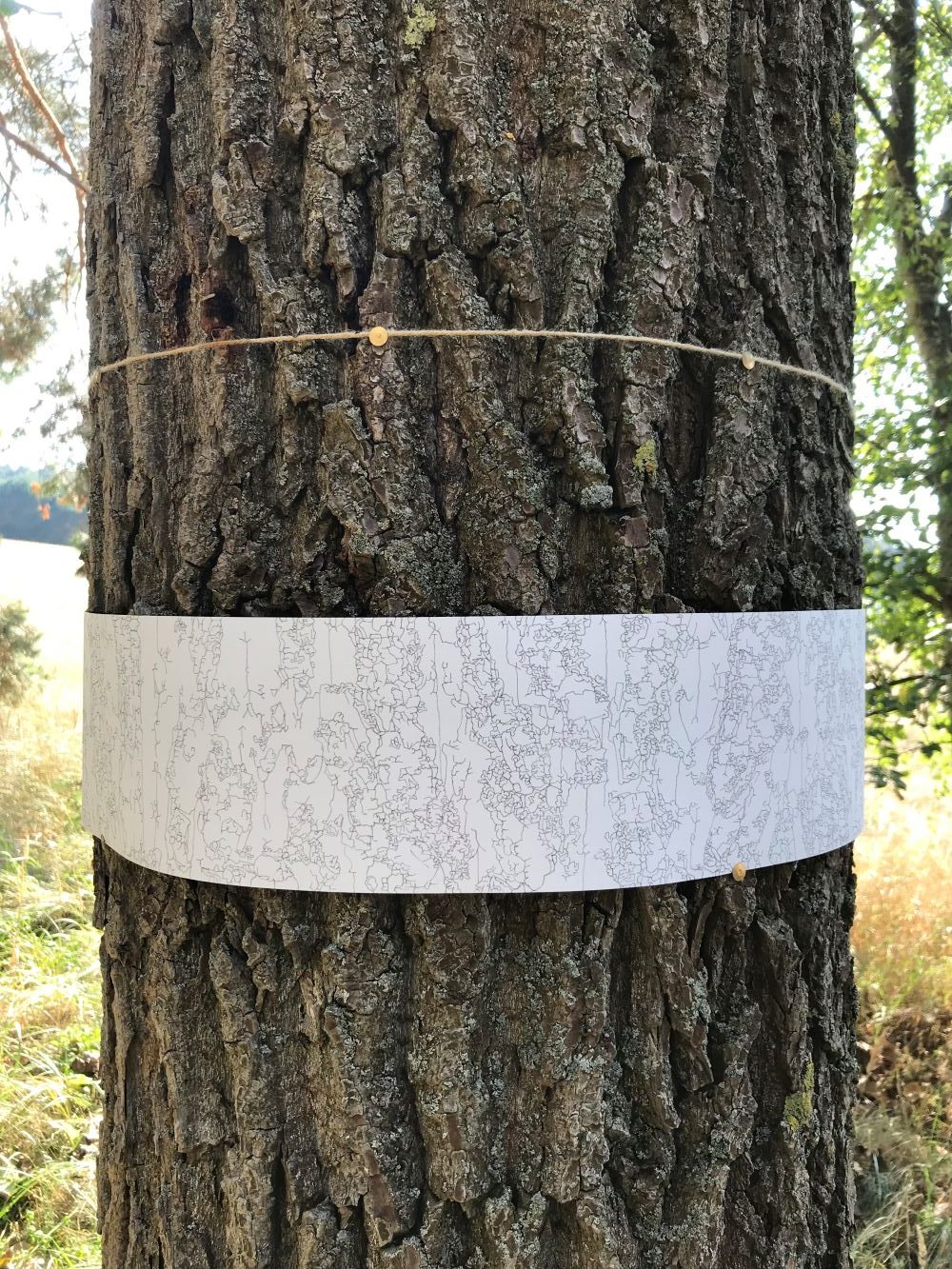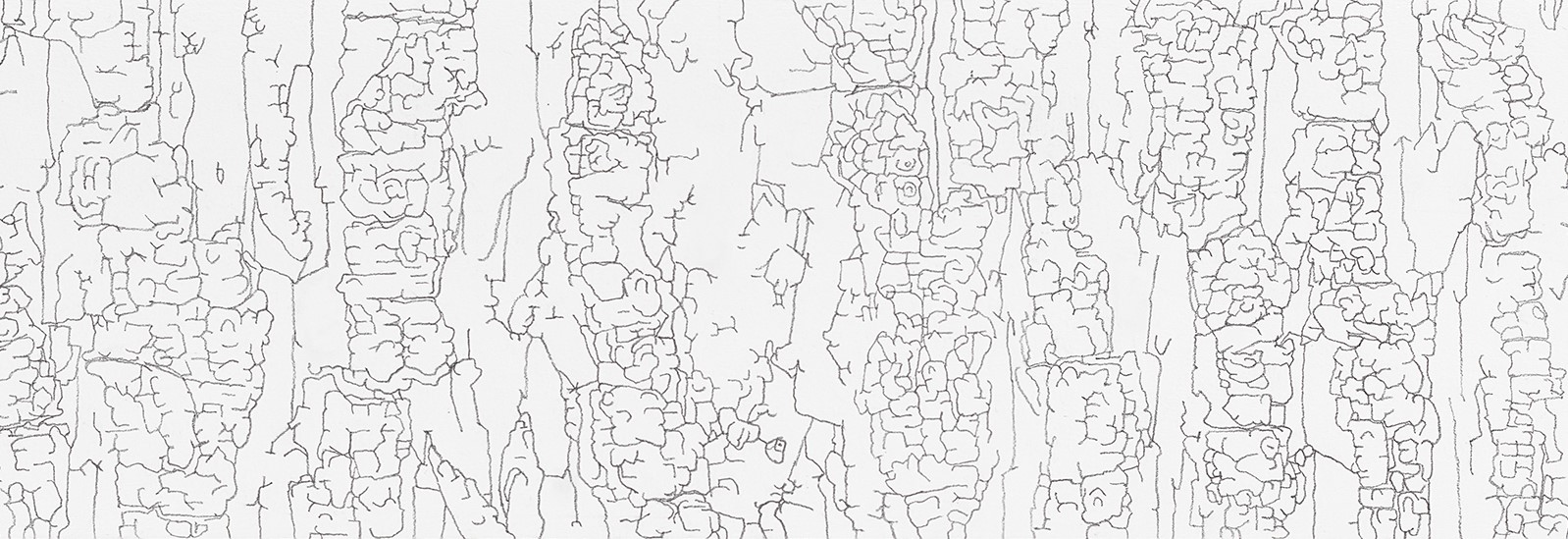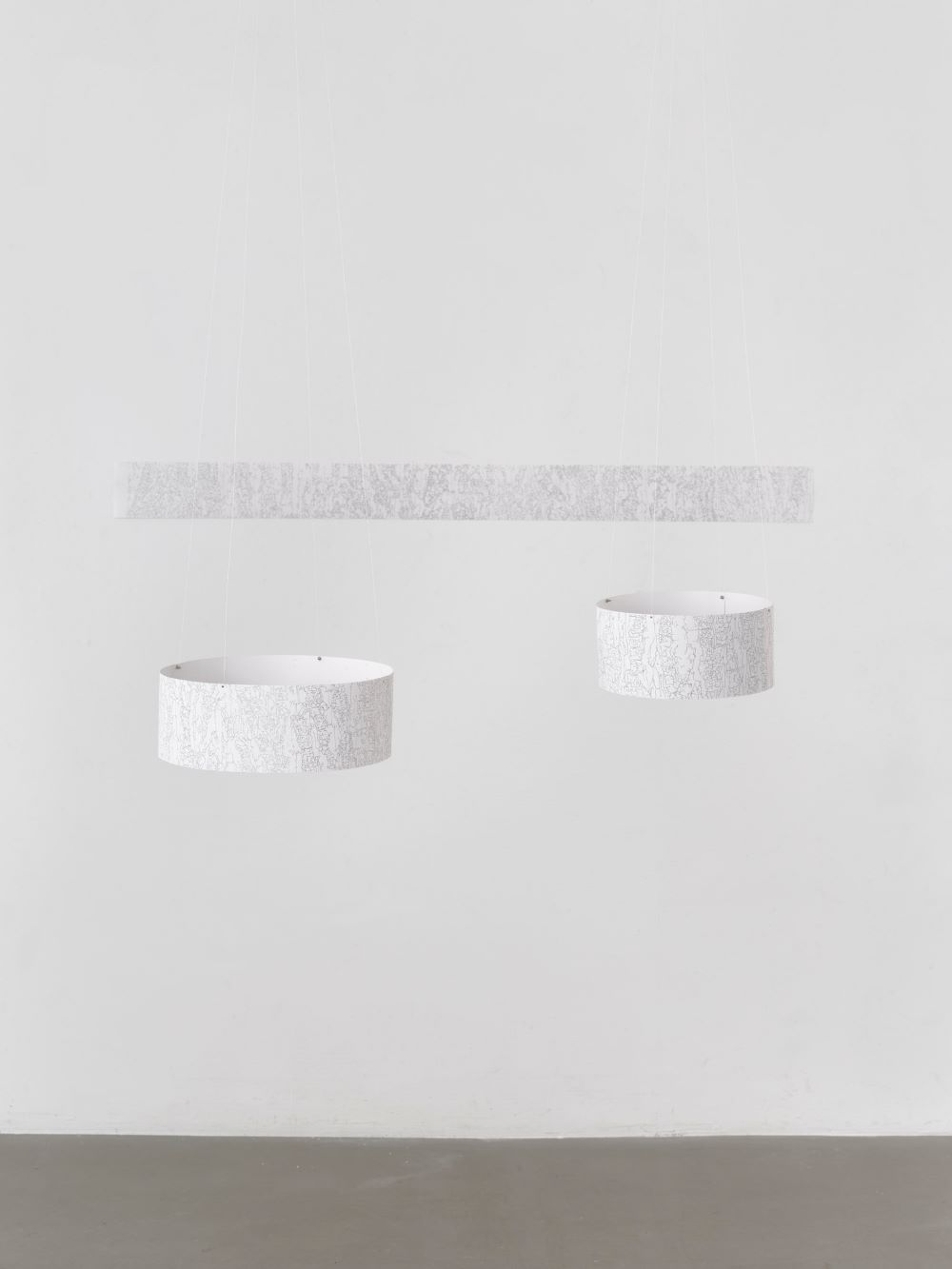Text: Oliver Thie | Section: Articles by Artists | Drawing Research
Abstract: Oliver Thie describes his understanding of drawing research in contrast to scientific research: precise recognition is realised within the framework of sensory experience. Perspectives that remain unaddressed by science are presented. Drawing research is understood as a variant of artistic research: it generates a type of knowledge that must be lived through and experienced. Thie uses a case study to illustrate his working method: the group of works Umrinden (Bark Encircling) transforms scientific methods into artistic world-accesses.
This text first appeared in the book Spiel Zufall Experiment. Zur künstlerischen Praxis (Game Chance Experiment. On Artistic Practice), Berlin 2024, ed. Willms Neuhaus Stiftung — Zufall und Gestaltung (Chance and Design). Republished here with kind permission. http://willms-neuhaus-stiftung.de/publikationen/
When I speak of research in relation to my work, I am not necessarily referring to scientific research. I am not bound by the strict criteria that usually apply in the (empirical) sciences for experiments and acquiring knowledge. Generally and practically speaking, my research is to be understood as a systematic exercise aimed at expanding knowledge, driven by an awareness of not-yet-knowing and a desire to understand, or wanting to know[1]. As a technique that enhances perception, drawing already inherently possesses the ability to conduct research in this sense; the term drawing research is thus essentially a reiteration of this concept. The knowledge gained here unfolds in two phases: first, through the experiences I encounter during the research process, i.e. while drawing; and second, through the perceptions that the resulting drawings subsequently reveal also to others.
Drawing activates deep concentration. With the pencil as one‘s walking aid, the eye takes on the ability to wander the field of vision like a grazing animal. In this way, I am able to explore all that is visible. I am able to notice the things we miss when our sensory attention is limited to convenient identification by fitting “the raw material we perceive into templates of relatively simple form”[2]. Drawing „enables a concretisation of the phenomena of interest, going far beyond everyday perception.“[3]
This concretisation facilitates precise recognition, which constitutes the specific knowledge sought in the first phase of drawing research. Furthermore, the shaping movement and the tactile response from the drawing tool can generate a sensation akin to physically touching the observed object itself. Both the motor skills and haptic perception involved in this process enrich visual cognition in a multi-sensory way, creating an even deeper, corporeal understanding. Drawing thus offers a way to achieve embodied knowledge[4], which is particularly useful when dealing with phenomena that are too small, too distant or otherwise inaccessible.
Drawing analysis enables us to select, distinguish, reduce, add, improvise and speculate; it directly documents every decision made and makes these decisions comprehensible to others. By translating them into graphic codes, I enter the realm of abstraction. Prior knowledge of the observed object – its name and context of meaning – fades into the background; what remains is pure thinking in forms. I can better carve out the individuality of each form than words ever could. At the same time, coincidences from the intrinsic life of the drawing apparatus (eye, nervous system, hand) inscribe themselves, revealing its dynamics.
The drawn image result creates a perceptual vehicle that records what has been precisely recognised as described above, and opens it up to intersubjective negotiation. As well as deeply immersing oneself in a research subject, another potential of drawing research is to externalise this empathic act and offer it as a perceptual possibility for others. The translation into drawing thus creates a transformation that also paves the way for new experiences. It opens up the possibility of looking at something and finding something else. Ambiguity arises, the perception of the observed becomes receptive to associations and comparisons.
I regard my approach to close observation, where everything, even the slightest movement of a louse’s foot, is already a discovery, as a qualitative data recording. With this, I intend to place sensory experience alongside a culture of knowledge dominated by the pursuit of quantitative results.
My particular focus is on the natural sciences, which evolved from my experience as a scientific illustrator. In close collaboration with biologists, I drew newly discovered insects several times for scientific journals. As Barbara Wittmann writes, „for the morphologist, the form of organisms is not simply a given; it must be painstakingly recovered, secured, even articulated, before one can derive knowledge about its structure and function.“[5]
This kind of articulation can hardly be achieved in any other way than through drawing. I had thus discovered for myself a domain in which, at least from a scientific understanding, drawing is recognised as a legitimate research tool. I was thrilled to be able to contribute to the understanding of nature as a draughtsman. At the same time, I also became familiar with the blind spots of scientific approaches from up close. Under the paradigm of provability, schematisations, limited perspectives and a selective focus at times obscure our view for diversity, individuality and a holistic understanding.
The fixed objectives that came with the contractual work relationship created too many constraints for my artistic research interests, and so I soon felt I had to move on. Today, I am no longer interested in making a scientific contribution in the narrow sense. Nevertheless, the cooperation with scientists remains an important starting point.[6] Their very specific interests in nature and the perceptual approaches their methodologies enable are my main source of inspiration. By devoting myself to the same subjects or incorporating moments of scientific methods into my drawing strategies, I want to reveal perspectives that remain unaddressed by science in a parallel research activity.
At this point, let drawing research be declared as a programme of artistic research.[7] My definition of a research-based approach involves a methodical procedure to acquire the above characterised mode of knowledge and a form of publication that makes individual certitudes available, thereby bringing them to general awareness. This affinity with the fundamental criteria of scientific research enables a comparison that clearly positions my endeavours as a variant within the fabric of knowledge production.
My methods consist of immersing myself in repeatable perceptual configurations and carrying out systematic drawing responses. As already expressed with the term embodied knowledge, drawing research produces a type of knowledge that must be lived and experienced. Therefore, after production, it also requires appropriate forms of presentation and reception.[8] I thus consider the exhibition format as a medium of publication that brings the research findings to fruition via the perceptions evoked by the drawings. The drawings are to be viewed intensively and at best in their original form; sometimes this is the only option because the formats resist reproduction. In addition, I provide written documentation and reflections that allow for the insights to be discussed on another level.
Case study: Umrinden (Bark Encircling)
To illustrate my working method and further discuss its connection to the natural sciences, I would like to go back a couple of years. In 2012, I spent six months in Brazil as part of a scholarship of the Gesellschaft für Internationale Zusammenarbeit (GIZ), where I was assigned to a working group at the Ministry of the Environment, involved in developing a nationwide programme for collecting biodiversity data. At first, no one knew what to do with an artist, as it was much more common to integrate biologists or environmental engineers. After some time being a silent observer, I eventually found a way to contribute. The long-term and large-scale research programme relied on the support of many helpers, which is why the local population was to be trained for participation. However, many of them are unable to read and so conventional teaching material was unsuitable. I made it my task to translate the methods of fieldwork into drawings for picture instructions. In this capacity, I was able to accompany several biological expeditions, since I had to experience the procedures first-hand in order to filter out the crucial steps and present them visually. One of these places was the Amazon rainforest, where I learned about the forest inventory procedure: in selected areas of inspection, all trees are numbered, their circumference at chest height is measured and recorded along with the corresponding number.

Since then, biological fieldwork has become a model for my artistic research endeavours. I learned how biologists use procedures based on systematic measurement, collection and observation to set a framework that also involves the decision to leave other aspects out. Within this framework, however, something lights up, is brought into focus, and it becomes possible to extract fragments from the contourless unknown. I call this principle world-access.
With my work, I would like to attempt something similar and thereby expand the scope of possibilities for world-accesses. I operate under the assumption that I can complement scientific explanatory models by approaching the world through subjective experience and striving for the perception of the individual rather than general theories.
“Phenomenology, the study of appearances, takes the multiplicity of things as a given fact, which must first of all be precisely observed and described. The application of phenomenology is characterised by as impartial an approach to the external world as possible. Initially, things are not analysed theoretically, or explained in relation to other things, but perceived as they appear. Objects are not viewed in isolation, but rather as situated entities in the world, all of which stand in relation to one another: this also includes the directed relationship of the knowing subject towards the object. The understanding of the subject’s involvement in the processes of perception and knowledge of objects constitutes a fundamental element of phenomenology. Phenomenological experience thereby involves the experience of the body and sensuality, the sensory reception of objects and their physical interaction, as well as the holistic perception of spatial environments. In phenomenology, the body is thus considered a prerequisite for the possibility of all perception. This undermines the traditional body-mind problem: in phenomenology, separating thought from bodily sensation and physical action is considered one of the fundamental ills of western philosophy.”
Dr. Georg Toepfer of the Leibniz Center for Literary and Cultural Research in email correspondence with Olivier Thie, November 2023.
In 2023, a residency in the Künstlerhaus Eisenhammer, situated in a small village in the Spree Forest, offered the opportunity to develop my own strategy for a forest-world-access through drawing. My initial plan was to observe aphids, as I had already done in the meantime during a different expedition in the US. Together with an insect specialist, I travelled through several states to track down species of these tiny creatures that live on specific host trees, all of them poplars. In the Spree Forest, I wanted to continue this work by investigating a relative of the American species that is native to Germany. I set my eyes on poplar trees, but despite finding several in the vicinity of the area, none of them had aphids. They didn’t seem to be present here, so I changed course and focused instead on the trees themselves. Due to my prior bias, I dedicated my study spanning several visits from May to October not just to any tree, but to a group of five poplars at the edge of the forest north-east of Schlepzig. (I am sure that such influences sometimes also play a role in the choice of a subject in scientific research.)
Based on the idea to artistically appropriate the scientific forest inventory and a keen interest in bark textures, I developed the following method: a 13cm high paper strip measuring the circumference of the trunk is placed around a selected tree just below eye level. The bark area above the strip is then marked with a thread at the same distance as the height of the paper. This zone is observed and a visual response is drawn on the paper below. I also established the following parameters for my drawing translation: to use a 6B graphite pencil and sharpen it sparingly, to only use (out)lines, to aim the pencil vertically to strive for relative proportional accuracy, to decide intuitively which forms to include or omit.



“The drawing unfolds a previously non-existent meaning that does not conform to any pre-defined project, yet is driven by an intention that merges with the movement, gesture and flow of the pencil stroke. Its delight lies in savouring this unfolding as it invents itself, finds itself and is propelled forward, pursuing that which was not yet there.”[9]
I wanted to capture the textures of the bark with eye and pencil, to grasp them and to experience what graphic impressions would emerge. The process of drawing recognition and marvelling at the transformation results unfolded a great sense of visual delight. But to reach this state of wonder, one must exceed the threshold of drabness that precedes it: the bark is monotone, bland and desolate; the thin and scraggly graphite lines ripple endlessly into white blankness. Before I can endure the seemingly monotonous sensory stimuli and begin to discover the hidden gems, my restless and spectacle-seeking mind must be brought to rest. Asceticism in both senses of the word — abstinence, but also practice — is needed. I sometimes find this challenging, although the rich sensory environment of the forest certainly helped. In the studio, my mind rebels much more strongly against the reduction of verbal activity; a myriad of inner voices rise up, demanding input or engaging in self-conversation with phantoms. Here, on the other hand, I let myself be carried by the diverse, incidental, pleasant stimuli.
A desired side-effect was learning to stand almost motionless in front of a tree for hours on end. With chest to bark, knee to gnarl, I myself became a tree. Admittedly a bold claim, but one which was reaffirmed when one day a deer trudged past me no more than three feet away, totally unperturbed by my presence.
With the changing of the seasons, not only did the surrounding fields transform, but the bark’s appearance shifted continuously. Human residents were nowhere to be seen; instead, multicoloured caterpillars with long hairs and teetering limbs paraded across the paper. I was often startled by ants that threw themselves at me with wide open pincers — or maybe at the pencil tip, which I soon couldn’t quite tell apart.
In my fieldwork, I aspire to immerse myself intensively in the habitat and the environment of the research subject, to experience it fully in order to become in tune with it to some extent. I hold the conviction that all cognition is dependent on a configuration that involves the body (again, see phenomenology). I would like to explore these connections and savour how they find their way into the subtlety of the drawing’s materiality.
The outcome of my excursions beyond the threshold of drabness can be seen in the five resulting drawings. Viewed chronologically, their wealth of detail progressively increases. My prolonged observations increasingly sharpened my vision, inevitably becoming immersed in subtle details that I was not aware of prior but must have been there nonetheless. It thus took me several days to discover tiny lichens on the side of a tree, which subsequently had to be incorporated into the drawing. This kind of sharpened vision cannot be undone. I moved further and further away from the superficial perception of the beginning, as if learning a new language that at first seems completely cryptic but is later registered almost effortlessly.
With the very wide horizontal format of the banderoles, I test out an unusual drawing format and offer a new perspective on the bark by allowing it to be viewed not only in the form of a ring but also unrolled and flat. However, as mentioned before, the research results are to be revealed through the drawings themselves. The viewer is also required to practice a certain visual asceticism here. My recommendation is to observe the drawings as one might listen to a concert: remain seated until the very last note is heard. With this I want to facilitate the transition to another temporality (tree time?). Helpful to this endeavour, Wilhelm Genazino discusses the concept of observation across time in his insightful essay Der gedehnte Blick (The Expanded Gaze):
“It seems we have internalised how much time we allow ourselves to view certain objects. We have all been trained to view images in rapid succession because otherwise we wouldn’t be able to cope with the sheer volume of visual stimuli around us. However, if we pause at an image for a moment longer than we are accustomed to, we enter what we may call the expanded gaze. The expanded gaze continues to see even when, according to general consensus (which would have long since moved on to the next image, and the one after that), there is nothing left to see. In other words, we could say: only once the generalised, sweeping gaze has registered the superficial structure of an image and thus deems it ‘completed’, only then is the expanded gaze truly activated.”[10]


The comparison to the original, scientific method remains. The high complexity of the drawn measurement corresponds better to the appearance of the measured object than a single number obtained through a quick metric circumference measurement could. In contrast to generalised terms such as species names, the individuality of each tree is taken into account. The immense deceleration of the drawing process allows a more intensive engagement with the research subject and its environment. Unlike number columns, the artistic dataset reflects the subjectivity of the observer in its results.
I do, on the other hand, also see similarities to the natural sciences. The decision to translate the bark structure only in lines led my gaze to seek primarily contrast edges. So from the very outset, a selective focus shapes my perception. The drawn strip only shows a slice of the tree trunk; it is a limited perspective and by no means representative of the diversity that a tree offers to consciousness. Does my attempt to complement scientific research in a sensory way ultimately contain an allegory for the crude schematisation[11] in the worldview of modern biology?

Details of the cover photo: Oliver Thie umrindet (encircles) a poplar tree (2023). Photo: Oliver Thie.
[1] Julian Klein, Was ist künstlerische Forschung?, kunsttexte.de 2011, p. 1.
[2] Rudolf Arnheim, Anschauliches Denken, Cologne 1977, pp. 37–38.
[3] Barbara Wittman, Morphologische Erkundungen. Zeichnen am Mikroskop, in: Matthias Bruhn and Gerhard Scholtz (eds.), Bildwelten des Wissens, vol. 9.2, Berlin 2013, pp. 45–54, here p. 45.
[4] Julian Klein in conversation with Martin Tröndle, Wie kann Forschung künstlerisch sein?, in: Martin Tröndle and Julia Warmers (eds.), Kunstforschung als ästhetische Wissenschaft, Bielefeld 2012, pp. 139-146, here pp. 145–146.
[5] Barbara Wittman, Morphologische Erkundungen. Zeichnen am Mikroskop, in: Matthias Bruhn and Gerhard Scholtz (eds.), Bildwelten des Wissens, vol. 9.2, Berlin 2013, pp. 45–54, here p. 45.
[6] Compare with: https://wissenschaft-kunst.de/oliver-thie-forschendes-zeichnen-teil-i/
[7] I do not intend to formulate a general theory of artistic research; rather, I am merely presenting my own position and aligning my work with this field of a particular art form. Also, I refer to the definition of science-related art as proposed by Peter Tepe:
“We may speak of science-related art when an artist draws on theories and/or methods and/or results from various sciences in their work process.” See: https://wissenschaft-kunst.de/fruehe-verbindungen-zwischen-wissenschaft-und-bildender-kunst/
[8] Julian Klein in conversation with Martin Tröndle, Wie kann Forschung künstlerisch sein?, in: Martin Tröndle and Julia Warmers (eds.), Kunstforschung als ästhetische Wissenschaft, Bielefeld 2012, pp. 139–146, here p. 146.
[9] Jean-Luc Nancy, Die Lust an der Zeichnung, Vienna 2011, p. 35.
[10] Wilhelm Genazino, Der gedehnte Blick, Munich 2004, pp. 42–43.(11) Paul Feyerabend, Wissenschaft als Kunst, Frankfurt am Main 1984, p. 42.
[11] Paul Feyerabend, Wissenschaft als Kunst, Frankfurt a. M. 1984, S. 42.
How to cite this article
Oliver Thie (2024): Drawing Research. w/k–Between Science & Art Journal. https://doi.org/10.55597/e9799


Be First to Comment